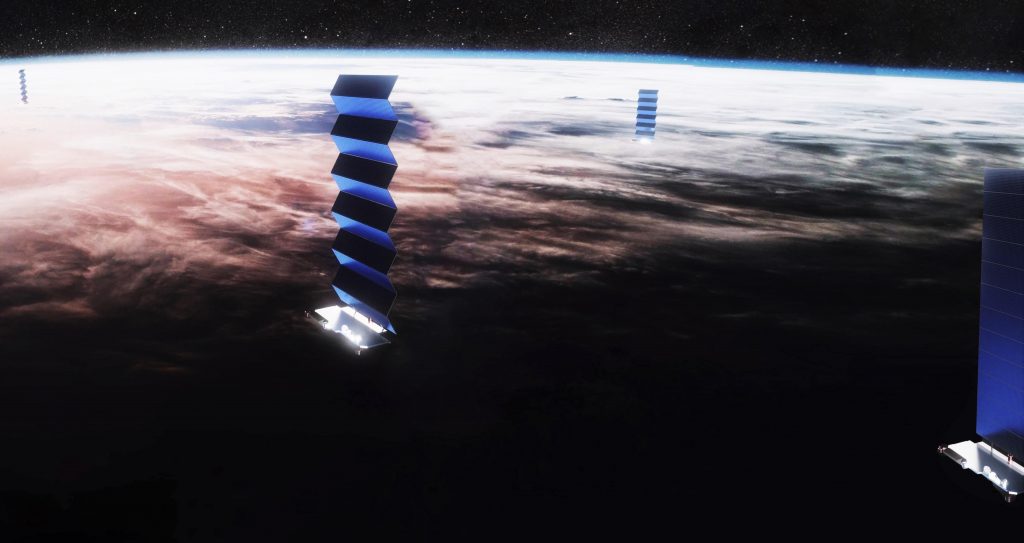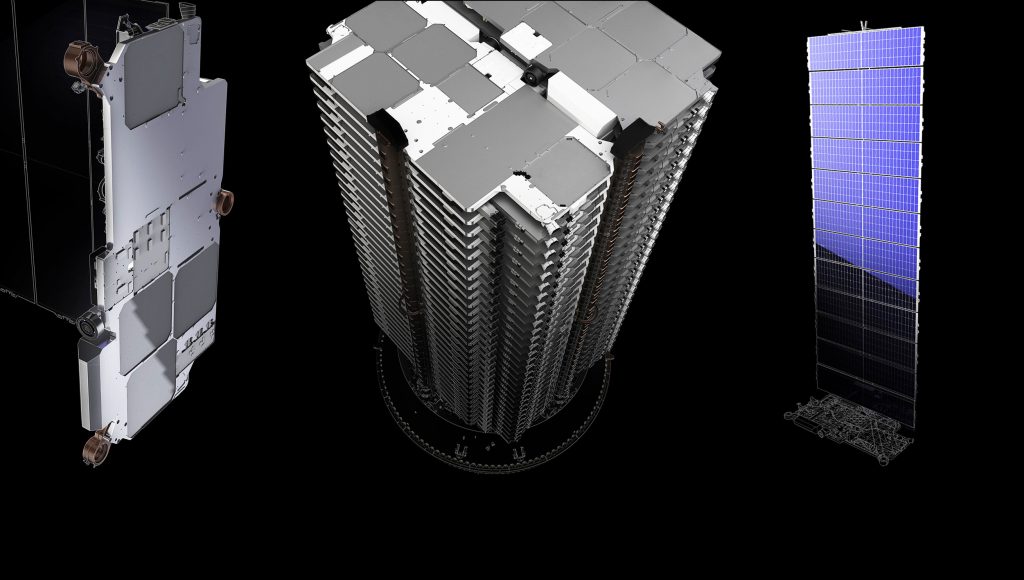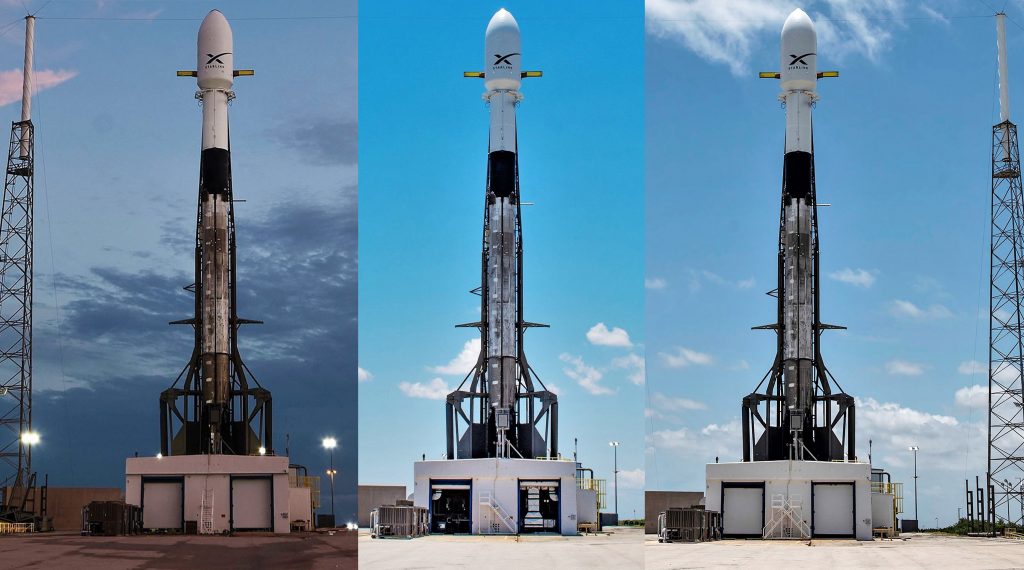According to a suite of eight FCC Special Temporary Authority licenses SpaceX filed for on August 30th, the company has plans for as many as four additional Starlink satellite launches in 2019, on top of Starlink’s May 23rd launch debut.
Additionally, SpaceX simultaneously requested that the FCC modify its current Starlink application to permit a slight change in orbital characteristics that would drastically improve the broadband satellite constellation’s coverage in its early stages. Combined, SpaceX appears to be extremely confident about the status and near-future progress to be made by its prospective Starlink constellation, confidence presumably inspired by the performance of the first 60 “v0.9” satellites launched three months ago.
Beta-test hiccups
Over the last three months, 50 of the 60 Starlink satellites launched on May 23rd have made their way to their final ~550 km (340 mi) circular orbits. As observed by astronomer Jonathan McDowell and partially confirmed by SpaceX’s own official statements, the company remains in contact with and – more or less – in control of all but three of the 60 Starlink prototypes. SpaceX did confirm in late June that two functioning satellites were being intentionally deorbited to test procedures and performance, while another three satellites had partially failed and were to “passively deorbit”.
And for completeness here is an updated version of the plot showing Starlink satellite height ((p+a)/2) versus time, no recent changes pic.twitter.com/E3a38afRse
— Jonathan McDowell (@planet4589) August 28, 2019
Based on the phrasing of SpaceX’s June 28th update, it’s ambiguous if communication and/or control has been completely lost with those three satellites. Additionally, five more satellites have remained paused partway between their ~440 km insertion orbits and ~550 km operational orbits, described two months ago as “going through checkouts prior to completing their orbit raise.” For unknown reasons, that orbit raise never happened. This leaves SpaceX with 57 of 60 satellites that have effectively ‘survived’ and are still under some form of control, while 50 (83%) of the satellites have successfully reached their nominal operational orbits and are performing as intended.
SpaceX continues to waffle between describing these first 60 satellites – internally known as “Starlink v0.9” – as a development test and the first operational Starlink launch. A ~17% failure rate for satellite orbit raising would be unacceptable for a finished product but, on a positive note, is actually quite impressive if one assumes that the 60 spacecraft are high-fidelity prototypes, not operational satellites.

In short, there is a lot of room for improvement – particularly in the realm of short and long-term reliability – but the likely fact that “v0.9” signifies a sort of Starlink beta test means that SpaceX’s next Starlink launches will feature updated and bug-fixed hardware. In the realm of satellites, the practice of flying prototypes as early as possible and risking failures to learn from experience is exceedingly rare, but this behavior is entirely consistent with SpaceX’s preferred approach to rocket and spacecraft development.
300 satellites, 7 months
As mentioned above, SpaceX applied for four FCC STA licenses – effectively communications-related launch permits – on August 30th, all for Starlink missions with nominal No Earlier Than (NET) launch dates in 2019. It must be noted that it’s exceptionally rare for the starting dates of STAs to actually correlate with launch dates, but a best-case scenario typically sees a given launch occur within a handful of weeks of that date. STAs last six months, providing plenty of buffer for all but the most extreme launch delays.
| Mission | Date (NET) |
| Starlink-1 | October 10th |
| Starlink-2 | October 25th |
| Starlink-3 | November 13th |
| Starlink-4 | December 8th |
Of note, NASASpaceflight.com recently published Cape Canaveral Air Force Station (CCAFS) and Kennedy Space Center (KSC) planning dates for SpaceX’s next two Starlink missions, confirming that the company is planning for launches roughly one week after the dates on its newly-requested FCC STAs. Those official planning dates show two back-to-back Starlink launches no earlier than (NET) October 17th and November 4th.

In a best-case scenario where SpaceX successfully manufactures, delivers, and prepares the satellites and readies the Falcon 9 rockets assigned to launch them, the company could complete four more Starlink launches between now and the New Year. Sticking to a three-week cadence hopefully set by Starlink-1 and Starlink-2, two more launches could follow around late-November and mid-December. Of course, as just the first few truly operational launches of more or less finalized “v1.0” Starlink satellites, delays from manufacturing through launch flows are probable and should be expected.
Even completing just one more 60-satellite launch of an updated Starlink design would be an impressive achievement, making SpaceX the first and only entity – country or company – to place more than 100 satellites in orbit in the first year of a satellite system’s launch activities. In a best-case scenario, four additional Starlink launches in 2019 would abruptly take SpaceX from two satellite prototypes to operating almost 300 satellites – unequivocally the largest constellation in the world – in no more than seven months.

Serving customers sooner
According to SpaceX’s Starlink.com website, Starlink will be able to start serving customers at Northern US and southern Canadian latitudes after just six launches (360 satellites), with limited “global coverage of the populated world” available after 24 launches (1440 satellites). However, per an FCC license modification request published on August 30th, the same day as 8 launch STAs, the company believes it can dramatically expedite Starlink coverage (regardless of launch rate) with one relatively simple modification.
This modification would leave inclination (orbit angle relative to Earth’s rotational axis), orbital altitude, and the number of satellites and launches completely unchanged, modifying Starlink’s orbital planes instead. It’s an extreme simplification of the reality of orbital mechanics, but one can imagine orbital planes as roughly akin to lanes on a road. To increase their reach, SpaceX wants to deploy Starlink satellites to three separate planes each launch, ultimately tripling the number of ‘lanes’ (from 24 to 72) while cutting the number of satellites in each ‘lane’ by two-thirds (from 66 to 22). In this analogy, it is logically easier to build fewer ‘lanes’, referring – in this case – to the challenge it poses to the launch vehicle, satellites, or both. SpaceX would only be able to triple Starlink’s orbital ‘lanes’ by requiring the satellites to do the bulk of their own orbit raising, leaning heavily on the performance and reliability of their SpaceX-built electric (ion) propulsion.
According to SpaceX, this could as much as halve the number of launches needed to achieve a given level of Starlink coverage, meaning that SpaceX’s early constellation could reach its initial operational status up to twice as quickly. SpaceX believes that this updated orbital layout of Starlink’s 1584 low Earth orbit (LEO) satellites would also significantly improve coverage and capabilities for areas with high population density (i.e. big cities).
Whether or not the FCC sees fit to rapidly grant SpaceX’s modification request in the next ~8 weeks, SpaceX’s next Starlink launches will be a major step forward for the company’s nascent communications constellation.
Check out Teslarati’s newsletters for prompt updates, on-the-ground perspectives, and unique glimpses of SpaceX’s rocket launch and recovery processes.

(adsbygoogle = window.adsbygoogle || []).push({});
<!–
–>
var disqus_shortname = «teslarati»;
var disqus_title = «SpaceX planning four more Falcon 9-launched Starlink missions this year, permits show»;
var disqus_url = «https://www.teslarati.com/spacex-starlink-falcon-9-four-more-launches-2019/»;
var disqus_identifier = «teslarati-113235»;

